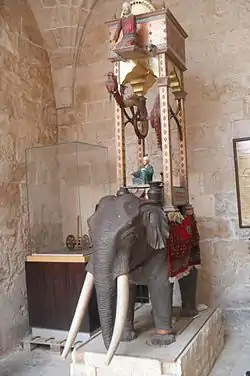Elephant clock
The elephant clock was a medieval invention by Ismail al-Jazari (1136–1206), an engineer and inventor of various clocks. The device consisted of a weight powered water clock in the form of an Asian elephant. The various elements of the clock are in the housing (howdah) on top of the elephant. In China a clock escapement mechanism was invented by the polymath Buddhist monk Yi Xing. Hydraulically powered waterwheels and water clocks were also used in the mechanically driven and rotated equatorial armillary sphere of Zhang Heng and Ma Jun. The elephant clock had some design differences compared to earlier waterclocks.
Upon finishing the development and construction of his elephant clock, Al-Jazari wrote: "The elephant represents the Indian and African cultures, the two dragons represent Chinese culture, the phoenix represents Persian culture, the water work represents Greek culture, and the turban represents Islamic culture," expressing his multicultural mentality.
Mechanism


The timing mechanism is based on a water-filled basin hidden inside the elephant. In the bucket is a deep bowl floating in the water, but with a small hole in the centre. The bowl takes half an hour to fill through this hole. In the process of sinking, the bowl pulls a string attached to a see-saw mechanism in the tower on top of the elephant. This releases a ball that drops into the mouth of a serpent, causing the serpent to tip forward, which pulls the sunken bowl out of the water via strings. At the same time, a system of strings causes a figure in the tower to raise either the left or right hand and the mahout (elephant driver at the front) to hit a drum. This indicates a half or full hour. Next, the snake tips back. The cycle then repeats, as long as balls remain in the upper reservoir to power the emptying of the bowl.[2]
Automaton
In the mechanism, a humanoid automaton strikes the cymbal and a mechanical bird chirps, as in the later cuckoo clock.
Passage of temporal hours
Another innovative feature of the clock was how it recorded the passage of temporal hours, which meant that the rate of flow had to be changed daily to match the uneven length of days throughout the year. To accomplish this, the clock had two tanks. The top tank was connected to the time-indicating mechanisms and the bottom was connected to the flow control regulator. At daybreak, the tap was opened and water flowed from the top tank to the bottom tank via a float regulator that maintained a constant pressure in the receiving tank.[3]
Modern reproductions
Several modern reproductions of the Elephant Clock have been created by the 1001 Inventions organisation. These reproductions are featured as part of the 1001 Inventions educational science shows that have been touring around the world since 2006. During a visit to the London Science Museum in January 2010, BBC journalist Nick Higham described the five metre high, working Elephant Clock replica produced by 1001 Inventions as "spectacular".[4][5]
A modern full-size working reproduction can be found as a centerpiece in the Ibn Battuta Mall, a shopping mall in Dubai, United Arab Emirates. Another working reproduction can be seen outside the Musée d'Horlogerie du Locle, Château des Monts, in Le Locle, Switzerland. Another can be found in the Museum of Science and Technology in Islam in the King Abdullah University of Science and Technology in Saudi Arabia.
References
- Ibn al-Razzaz Al-Jazari (ed. 1974), The Book of Knowledge of Ingenious Mechanical Devices. Translated and annotated by Donald Routledge Hill, Dordrecht/D. Reidel.
- Robinson, Andrew (2007), The Story of Measurement: From Cubits to Megabytes, Thames & Hudson, ISBN 978-0-500-51367-5
- Ahmad Y Hassan; Donald Routledge Hill (1986), Islamic Technology: An Illustrated History, Cambridge University Press, pp. 57–59, ISBN 0-521-26333-6
- "Science Museum exhibition of Muslim heritage". BBC News. 21 January 2010. Retrieved 2 December 2014.
- "1001 Inventions: Discover the Muslim Heritage in Our World". Time Out London. Retrieved 2 December 2014.
External links
| Wikimedia Commons has media related to Elephant clocks. |
- Article including a photograph of the Ibn Battuta Mall elephant clock.
- Information from the Metropolitan Museum, New York.
- Saudi Aramco World: The Third Dimension by Richard Covington, including Dr Fuat Sezgin, his museum of Arabic–Islamic science in Frankfurt, and in particular a model of the elephant clock.
- Elephant Clock (English) on Vimeo
